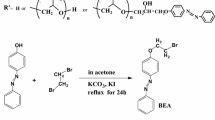Abstract
Cellulose β-ketoesters having long alkyl or alkenyl chains were prepared by homogeneous reactions with alkyl or alkenyl ketene dimmers (OKD or AKD), and were characterized by X-ray diffractometory, differential scanning calorimetry, optical microscopy with cross polarizers and others. The Cellulose/OKD and AKD β-ketoesters with degrees of substitution (DS) of more than 1.5 were gummy solid at room temperature and had birefringence due to liquid crystalline structures in wide temperature range. The liquid crystalline/isotropic phase transition points were 150–175 °C, depending on the DS and substituents introduced into cellulose hydroxyls. X-ray diffraction patterns indicated that cellulose backbones had disordered structures at room temperature, while alkyl chains in the substituents formed ordered or crystalline domains in the cellulose β-ketoesters. Films of the cellulose/AKD β-ketoesters prepared by casting their chloroform solutions on glass plates had highly hydrophobic nature, and contact angles of water droplet on the films were more than 90°. The water-contact angles on the films decreased to some extent just after heating of the films at 105 °C, whereas they were gradually recovered to the initial values by conditioning at ambient temperature.
Similar content being viewed by others
References
Carsten T. (1996) Molecular self-organization of amphotropic liquid crystals. Progress Polym. Sci. 21: 775–852
Cowie J.M.G., Arrighi V., Cameron J., McEwan I., McEwen I.J. (2001) Lyotropic liquid crystalline cellulose derivatives in blends and molecular composites. Polymer 42: 9657–9663
Hou H., Reuning A., Joachim H., Wendorff J.H. and Greiner A. (2000) Tuning of the pitch height of thermotropic cellulose esters. Macromol. Chem. Phys. 201: 2050–2054
Isogai A., Ishizu A. and Nakano J. 1986. Preparation of tri-O- alkylcelluloses by the use of a non-aqueous cellulose solvent and their physical characteristics. J. Appl. Poly. Sci. 31:␣341–452
Ito T., Tsujii Y., Suzuki H., Fukuda T., Miyamoto T. (1992) Monolayer and multilayer Langmuir-Blodgett films of cellulose tri-n-alkyl esters studied by transmission electron microscopy. Polym. J. 24: 641–652
McCormick C.L. 1981. U.S. Patent 4,278,790
Pawlowski W.P., Gilbert R.D. (1988) The liquid-crystalline properties of selected cellulose derivatives. J. Polym. Sci., Polym. Phys. 26: 1101–1110
Sealey J.E., Samaranayak G., Todd J.G. and Glasser W.G. 1996. Novel cellulose derivatives. IV. Preparation and thermal analysis of waxy esters of cellulose. Polym Sci. Polym. Phys. 34: 1613–1620
Shimamura K., White J.L., Fellers J.F. (1981) Hydroxypropylcellulose, a thermotropic liquid crystal: Characteristics and structure development in continuous extrusion and melt spinning. J. Appl. Polym. Sci. 25: 2165–2180
Takada A., Fujii K., Watanabe J., Fukuda T., Miyamoto T. (1994) Chain-length dependence of the mesomorphic properties of fully decanoated cellulose and cellooligosaccharides. Macromolecules 27: 1651–1653
Takada A., Fujii K., Fukuda T., Watanabe J., Miyamoto T. (1995) Orientation-dependent interactions in polymer systems. 5. Thermotropic liquid crystalline transition of tri-O-heptylcellulose. Macromolecules 28: 3394–3400
Teramoto Y., Nishio Y. (2004) Biodegradable cellulose diacetate-graft-poly(l-lactide)s: Thermal treatment effect on the development of supramolecular structures. Biomacromolecules 5: 397–406
Tujii Y., Ito T., Fukuda T., Miyamoto T., Ito S. and Yamamoto, M. 1992. Multilayer films of chromophoric cellulose octadecanoates studied by fluorescence spectroscopy. Langmuir 8: 936–941
Turbak A.F., EL-Katrawy A., Synder F.W. and Auerbach A.B. 1980. U.S. Patent 4,302,252
Yamagishi T., Fukuda T., Miyamoto T., Watanabe J. (1988) Thermotropic cellulose derivatives with flexible substituents II. Effect of substituents on thermal properties. Polym. Bull. 20: 373–377
Yoshida Y., Yanagisawa M., Isogai A., Suguri N., Sumikawa N. (2005) Preparation of polymer brush-type cellulose β-ketoesters using LiCl/1,3-dimethyl-2-imidazolidinone as a solvent. Polymer 46: 2548–2557
Zhou Q., Zhang L., Okamura H., Minoda M., Miyamoto T. (2001) Synthesis and properties of –2-[2-(2-methoxyethoxy)ethoxy]acetyl cellulose. J. Polym. Sci., Polym. Chem. 39: 376–382
Acknowledgement
This research was supported by a Grand-in-Aid for Scientific Research (Grant number 15658052) from the Japan Society for the Promotion of Science (JSPS). Mr. Kazumichi Asakura of NOF Corporation, Japan, kindly provided alkylketene dimers.
Author information
Authors and Affiliations
Corresponding author
Rights and permissions
About this article
Cite this article
Yoshida, Y., Isogai, A. Thermal and liquid crystalline properties of cellulose β-ketoesters prepared by homogeneous reaction with ketene dimers. Cellulose 13, 637–645 (2006). https://doi.org/10.1007/s10570-006-9089-5
Received:
Accepted:
Published:
Issue Date:
DOI: https://doi.org/10.1007/s10570-006-9089-5




